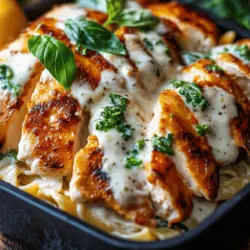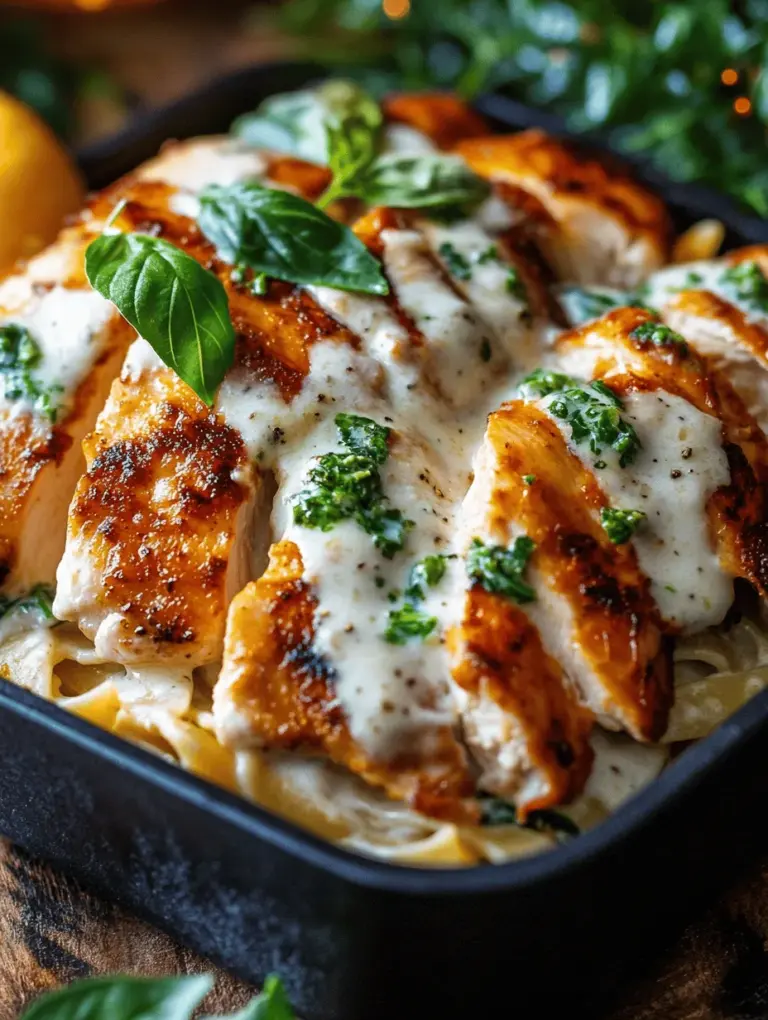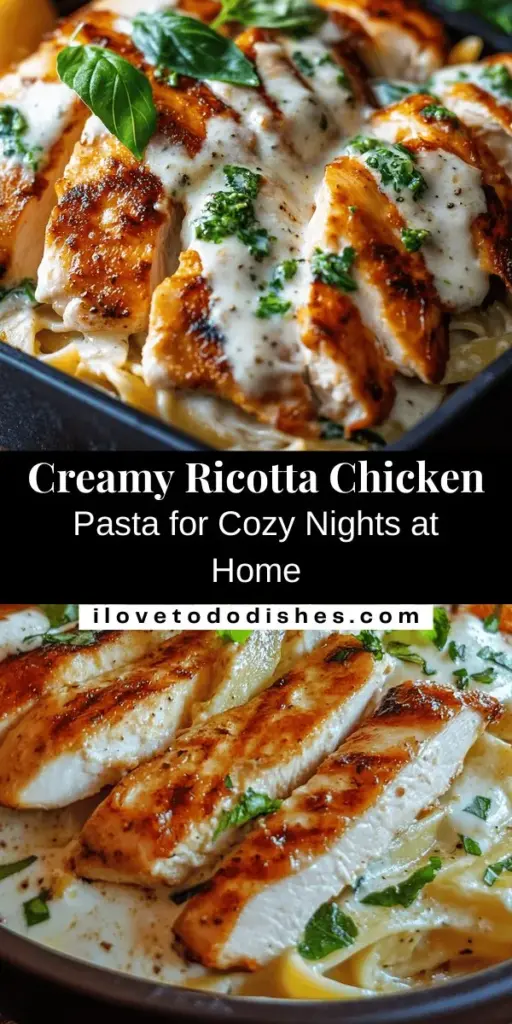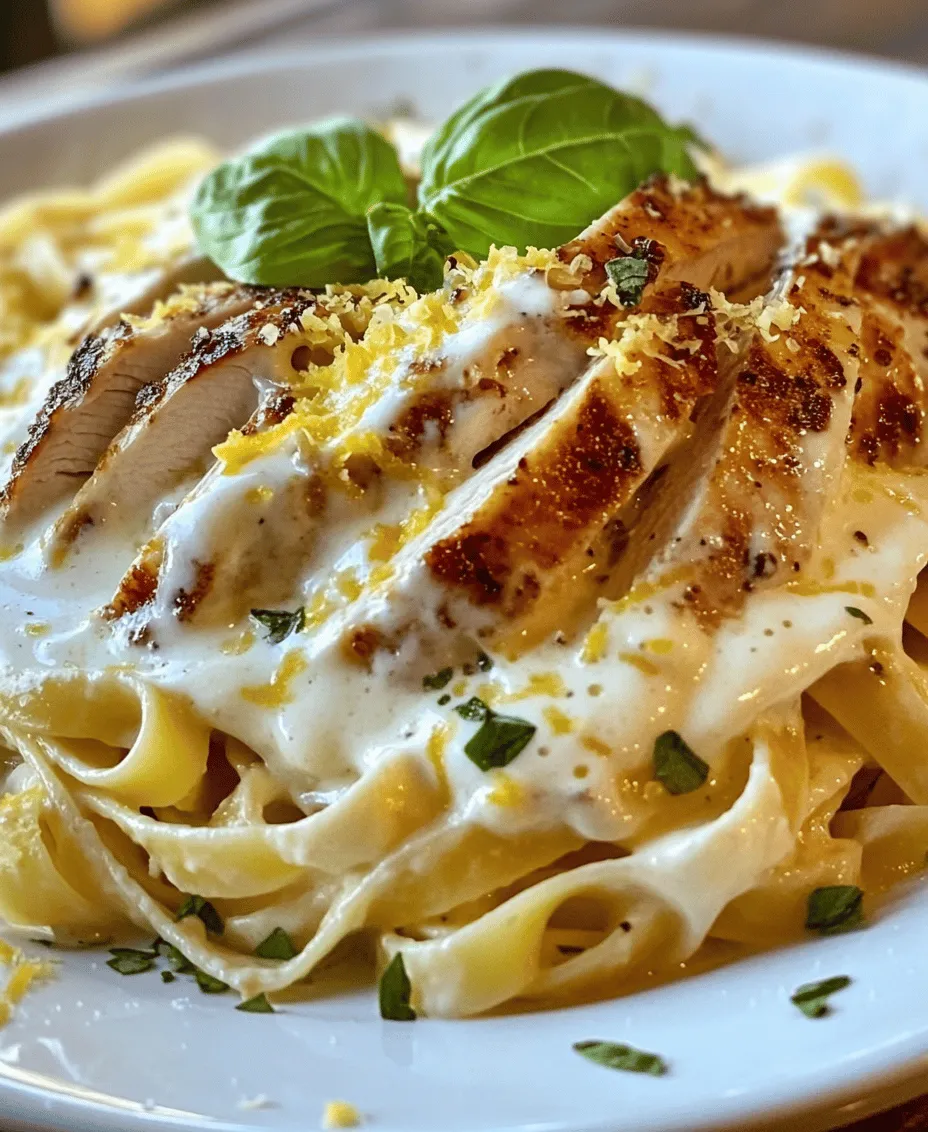When it comes to a satisfying and hearty meal, few dishes can rival the comfort of creamy pasta. Today, we’re diving into a delightful recipe for Creamy Ricotta Chicken Pasta, a dish that brings together rich flavors and a creamy texture that envelops every strand of pasta. This recipe is not only delicious but also packed with nutritional benefits, making it a perfect choice for a weeknight dinner or meal prep.
The Appeal of Creamy Ricotta Chicken Pasta
Creamy Ricotta Chicken Pasta stands out for its combination of flavors and textures. The creamy ricotta cheese melds beautifully with the tender chicken, creating a luscious sauce that clings to whole grain pasta. This dish is not only satisfying but also offers a nutritional punch thanks to its wholesome ingredients. Whole grain pasta provides fiber and essential nutrients, while the addition of fresh spinach boosts the meal’s vitamin content.
The beauty of this dish lies in its versatility; it can be dressed up for a dinner party or simplified for a quick weeknight meal, making it a go-to recipe for any occasion. The combination of tender chicken, creamy ricotta, and vibrant spinach makes each bite a delightful experience, inviting you to savor the moment.
Understanding the Ingredients
Before we dive into the cooking process, it’s essential to understand the key ingredients that make this dish shine. Each component plays a significant role in flavor and nutrition.
Whole Grain Pasta
Whole grain pasta is a fantastic choice for this recipe. Unlike traditional white pasta, whole grain varieties retain the bran and germ, offering a richer flavor and higher nutritional value. They are an excellent source of fiber, which aids digestion and keeps you feeling full longer. When cooked al dente, whole grain pasta adds a delightful chewiness that complements the creamy sauce perfectly.
Chicken Breasts
Chicken breasts are the star protein in this dish, providing a lean source of meat that is both versatile and nutritious. Rich in protein, chicken breasts are an excellent choice for those looking to maintain muscle mass or lose weight. When preparing chicken for this recipe, it’s crucial to season it well and choose the right cooking method to ensure it remains juicy and flavorful.
Ricotta Cheese
Ricotta cheese is what makes this pasta dish truly creamy and rich. Its mild flavor and velvety texture create a luxurious sauce that enhances the overall dish. Ricotta is also a good source of protein and calcium, contributing to its nutritional profile. It’s essential to choose a high-quality ricotta for the best results—look for fresh, whole-milk varieties for optimal creaminess.
Parmesan Cheese
Parmesan cheese adds a depth of flavor to the dish, enhancing the overall taste with its sharp, nutty profile. This hard cheese is often used to finish pasta dishes, providing a salty, umami kick that perfectly complements the creaminess of ricotta. When using Parmesan, freshly grated cheese is always best, as it melts beautifully into the sauce and provides an irresistible flavor boost.
Spinach
Spinach is not just a colorful addition to the dish; it also packs a nutritional punch. Rich in vitamins A, C, and K, as well as iron and antioxidants, spinach brings a wealth of health benefits. Its subtle flavor pairs beautifully with the other ingredients while adding a fresh, vibrant touch. Sautéing the spinach helps to wilt it quickly, incorporating it into the dish without losing its nutrients.
Garlic and Lemon
Garlic and lemon are essential components that elevate the flavors of this creamy pasta. Garlic adds a robust aroma and depth, while lemon brings brightness and acidity, balancing the richness of the sauce. Together, they enhance the dish’s overall flavor, making it more complex and enjoyable.
Optional Ingredients
For those who enjoy a little kick, consider adding red pepper flakes to your dish. This optional ingredient introduces a hint of spice that can elevate the overall experience, providing a delightful contrast to the creamy sauce.
Step-by-Step Instructions
Now that we’ve covered the essential ingredients, it’s time to walk through the preparation and cooking steps to create this creamy delight.
Preparation Before Cooking
Before you begin cooking, it’s crucial to gather all your ingredients and tools. Having everything on hand will make the cooking process smoother and more enjoyable. Here’s what you’ll need:
– A large pot for boiling pasta
– A large skillet for cooking chicken and making the sauce
– A cutting board and knife for chopping
– Measuring cups and spoons for accurate ingredient measurements
– Tongs or a slotted spoon for handling the pasta
Cooking the Pasta
The first step in your creamy ricotta chicken pasta adventure is cooking the pasta. Follow these steps to achieve the perfect al dente texture:
1. Boil Water: Fill a large pot with water and bring it to a rolling boil. Make sure to add a generous amount of salt—this is your only chance to season the pasta itself.
2. Add the Pasta: Once the water is boiling, add the whole grain pasta and stir gently to prevent it from sticking. Check the package instructions for cooking times, but generally, whole-grain pasta takes around 8-10 minutes to cook.
3. Reserve Pasta Water: Before draining the pasta, reserve about 1 cup of the pasta cooking water. This starchy water will help create a silky sauce later.
4. Drain the Pasta: Once the pasta is cooked to your liking, drain it in a colander, but do not rinse it. Rinsing removes the starch that helps the sauce adhere to the pasta.
Cooking the Chicken
While your pasta is cooking, you can prepare the chicken. Here’s how to ensure it’s juicy and flavorful:
1. Seasoning: Pat the chicken breasts dry with paper towels to remove excess moisture. Season both sides generously with salt and freshly cracked black pepper. You can also add garlic powder or Italian seasoning for extra flavor.
2. Cooking Method: Heat a tablespoon of olive oil in a large skillet over medium-high heat. Once the oil is hot, carefully add the seasoned chicken breasts. Cook for about 5-7 minutes on each side, or until the chicken is golden brown and cooked through. The internal temperature should reach 165°F (75°C) for safe consumption.
3. Rest the Chicken: Once cooked, transfer the chicken to a cutting board and let it rest for a few minutes before slicing it into bite-sized pieces. This resting period allows the juices to redistribute, ensuring moist chicken.
Sautéing Garlic
While the chicken is resting, it’s time to sauté the garlic. This step is crucial for building flavor in your creamy sauce:
1. Add Garlic: In the same skillet used for the chicken, add a touch more olive oil if necessary. Lower the heat to medium and add minced garlic. Sauté for about 30 seconds, stirring constantly to avoid burning.
2. Infuse Flavor: As the garlic becomes fragrant, it will begin to turn golden. This is the perfect moment to add your reserved pasta water, ricotta, and seasonings to create your creamy sauce.
With these initial steps completed, you’re well on your way to serving up a delicious plate of Creamy Ricotta Chicken Pasta. The combination of tender chicken, creamy sauce, and whole grain pasta will surely become a favorite in your household. Stay tuned for the next part, where we will delve into finishing the dish and serving it up beautifully!
Creating the Sauce
To achieve the perfect creamy sauce for your Ricotta Chicken Pasta, start by blending the ricotta cheese and freshly grated Parmesan cheese. This combination creates a rich, velvety texture that coats the pasta beautifully.
Blending Ricotta and Parmesan for Optimal Creaminess
In a medium-sized mixing bowl, add 1 cup of ricotta cheese along with 1/2 cup of finely grated Parmesan cheese. Use a whisk or an electric mixer to blend the two until they form a smooth, creamy mixture. This step is crucial as it ensures that the cheese is evenly distributed throughout the sauce, providing a luxurious mouthfeel. The Parmesan adds a sharp, nutty flavor that balances the mild ricotta, enhancing the overall taste of the dish.
Techniques for Adjusting Sauce Consistency Using Reserved Pasta Water
Once the pasta is cooked al dente and drained, reserve about 1 cup of the pasta cooking water before draining. This starchy water is a secret weapon in pasta dishes, as it can be used to adjust the sauce’s consistency. If your ricotta sauce is too thick, gradually add small amounts of the reserved pasta water while stirring. The starch in the water will help emulsify the sauce, making it creamier and allowing it to cling better to the pasta. Aim for a silky, smooth texture that lightly coats the pasta without being overly watery.
Adding Spinach
Spinach is a perfect addition to this dish, providing a pop of color and essential nutrients. It’s important to incorporate the spinach properly to avoid overcooking, which can lead to a soggy texture and loss of vibrant color.
How to Properly Incorporate Spinach Without Overcooking
To add fresh spinach to your pasta dish, use about 2 cups of fresh baby spinach. After you’ve combined the ricotta and Parmesan mixture into the pasta, fold in the spinach gently over low heat. The residual heat from the pasta and sauce will wilt the spinach just enough to soften it without losing its bright green hue and nutritional value. This quick cooking method retains the spinach’s flavor and ensures it remains a vibrant addition to your dish.
Combining Ingredients
To achieve an evenly coated pasta dish, it’s essential to combine all ingredients thoroughly.
Tips for Ensuring Even Coating of Pasta and Chicken in Sauce
Once the spinach has wilted, add the cooked chicken pieces back into the pasta bowl. Then, gently fold the ricotta sauce into the pasta, chicken, and spinach mixture. Use a pair of tongs or a large spoon to toss everything together, ensuring that each strand of pasta is coated with the creamy sauce. If the pasta seems dry, add a little more reserved pasta water until you reach the desired creaminess. Taste and adjust seasoning with salt and pepper as needed to enhance the flavors.
Serving Suggestions
Presentation plays a significant role in making your Creamy Ricotta Chicken Pasta visually appealing.
Ideas for Garnishing and Presentation
To serve, transfer the pasta to individual plates or a large serving bowl. For an elegant touch, sprinkle a little extra grated Parmesan cheese on top and some freshly cracked black pepper. A sprinkle of chopped fresh basil or parsley not only adds color but also a fresh herbal note that complements the creamy sauce beautifully. For a hint of zest, consider adding a squeeze of lemon juice over the top before serving, which will brighten the flavors and balance the richness of the dish.
Nutritional Information
Understanding the nutritional breakdown of your meal is essential for making informed dietary choices.
Breakdown of Nutrients Per Serving
A serving of Creamy Ricotta Chicken Pasta typically contains approximately:
– Calories: 450
– Protein: 30g
– Carbohydrates: 50g
– Fat: 15g
– Fiber: 3g
These values may vary based on portion size and specific ingredient brands used.
Discussion on Health Benefits of Each Ingredient
– Ricotta Cheese: A great source of protein and calcium, ricotta is lower in fat compared to many other cheeses. Its creamy texture adds a luxurious feel to the dish without excessive calories.
– Chicken: Lean chicken breast provides essential proteins that are crucial for muscle building and repair.
– Spinach: Packed with vitamins A, C, and K, spinach is also rich in iron and antioxidants, contributing to overall health.
– Pasta: While often considered a carbohydrate-heavy ingredient, whole grain or legume-based pasta options elevate fiber intake, making the dish more satiating.
Comparison to Traditional Pasta Dishes
Compared to traditional creamy pasta dishes that often rely on heavy cream and butter, Creamy Ricotta Chicken Pasta offers a lighter, healthier alternative without sacrificing flavor. The use of ricotta significantly cuts down on calories and fat while still delivering a satisfying creaminess.
Variations and Customizations
One of the best aspects of pasta dishes is their versatility.
Suggestions for Protein Alternatives
If you’re looking to switch up the protein, consider using shrimp or tofu. Shrimp can be sautéed quickly in olive oil until pink and juicy, while tofu can be cubed and pan-fried for a crispy texture. Both options provide a delicious alternative to chicken while maintaining the dish’s overall integrity.
Options for Making It Vegetarian or Vegan
To make the dish vegetarian, simply omit the chicken and add more vegetables, such as mushrooms, zucchini, or bell peppers. For a vegan version, substitute the ricotta with a plant-based ricotta or a cashew cream. Using nutritional yeast instead of Parmesan can also add a cheesy flavor without dairy.
Ideas for Adding Seasonal Vegetables or Different Herbs
Feel free to incorporate seasonal vegetables based on availability. Asparagus in the spring, zucchini in the summer, or butternut squash in the fall can elevate this dish. Additionally, experimenting with herbs like thyme, oregano, or even a hint of rosemary can introduce new flavor profiles that keep the dish exciting.
How to Adjust Spices for Different Flavor Profiles
For those who enjoy a bit of heat, consider adding crushed red pepper flakes or a dash of cayenne pepper to the sauce. Alternatively, a sprinkle of smoked paprika can provide a smoky depth that complements the creaminess of the cheese. The key is to adjust spices according to your preference while ensuring they harmonize with the other ingredients.
Storing and Reheating
If you have leftovers (which is unlikely given how delicious this dish is), it’s essential to store them properly to maintain flavor and texture.
Guidelines for Storing Leftovers
Allow any leftover Creamy Ricotta Chicken Pasta to cool to room temperature before transferring it to an airtight container. It can be stored in the refrigerator for up to three days. If you plan to keep it longer, consider freezing it.
Best Practices for Reheating to Maintain Flavor and Texture
When reheating, you can do so on the stove over low heat, adding a splash of reserved pasta water or a little olive oil to keep the sauce creamy. Stir frequently to prevent sticking and ensure even heating. Alternatively, if using a microwave, cover the dish to retain moisture and heat in short intervals, stirring in between.
Tips on Freezing the Dish and Defrosting
If freezing, portion out the pasta into individual servings for convenience. To defrost, transfer the pasta from the freezer to the refrigerator the night before you plan to eat it. Reheat as described above for best results.
Conclusion
Making Creamy Ricotta Chicken Pasta is not only a delicious endeavor but also a satisfying experience that brings comfort to any meal. With its rich, creamy sauce, tender chicken, and nutritious spinach, this dish is a delightful addition to your recipe repertoire.
Encourage your creativity by experimenting with various protein options, vegetables, and spices. Each variation can yield a unique twist on this classic dish, ensuring that you never tire of it.
The simplicity and satisfaction of preparing this comforting meal at home will make it a favorite for family dinners or gatherings with friends. Embrace the process, enjoy the flavors, and share your culinary creations with loved ones!



